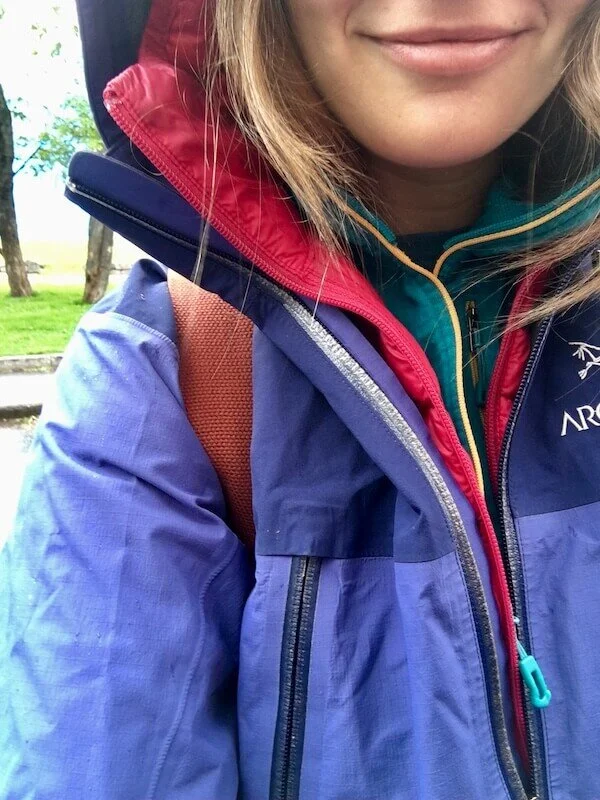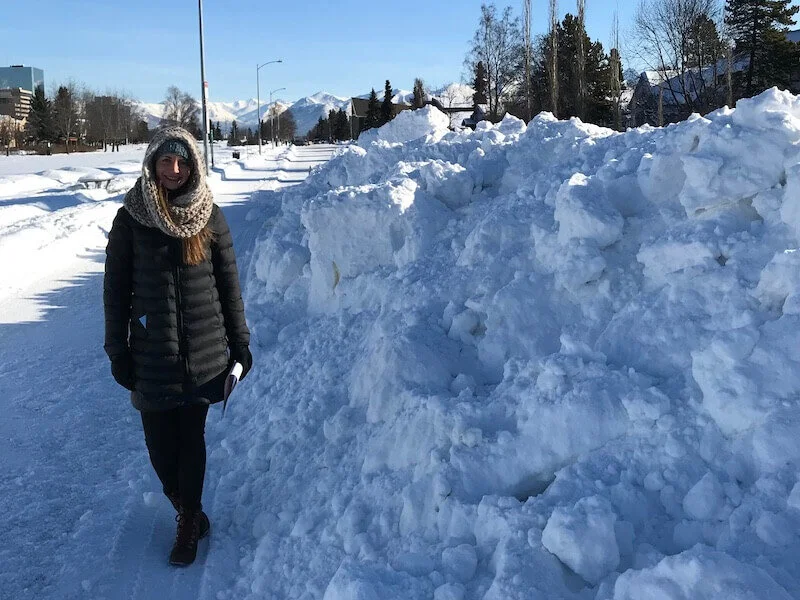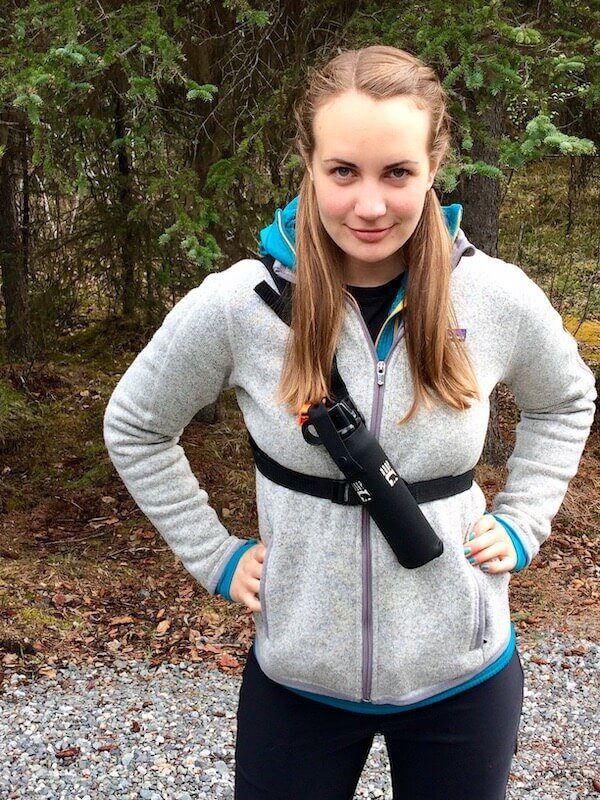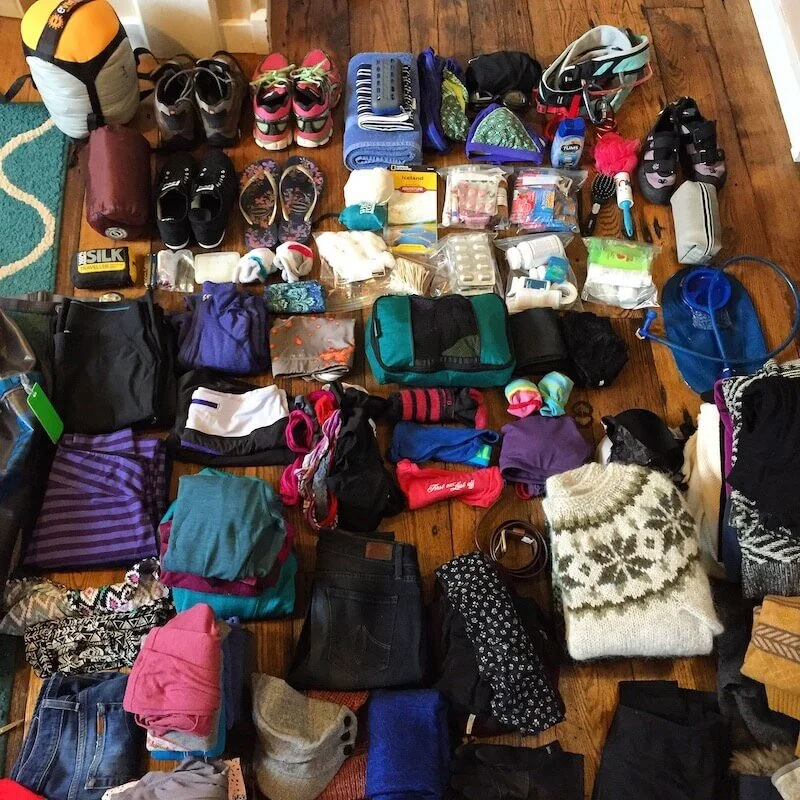What to Pack for a Trip to Alaska
You’re starting to pack for your big trip to Alaska! As you prepare for your journey, you might wonder about the essential clothing and gear you'll need to pack. We understand the feeling, as it's always better to be fully equipped for any adventure that comes our way, whether it's a trip to Paris or Patagonia. That's why we are here to help!
Let's take a closer look at what you should consider packing for your Alaska trip, including different seasons, activities, and adventures.
Read more about the best time to visit Alaska.
February in Anchorage, Alaska
Seasons in Alaska
Summer in Alaska (June, July, August)
Welcome to the beautiful summer season in Alaska! The three summer months bring a much-needed respite from the long winter months. During this time, the state experiences almost no darkness except for the twilight in the southern regions. However, it's important to be aware that certain parts of Alaska can be quite buggy during this season. The temperatures are generally mild, ranging from mid-50s to mid-70s, depending on your location within the state.
Don’t forget to pack:
Bug Spray
Eye Mask
Sun Glasses
Read more about visiting Alaska in June, July, and August.
Autumn in Alaska (September, October)
Alaska's autumn season, like summer, passes by quickly. Though many places in the United States have long and vibrant autumn seasons, in Alaska, it can be easy to miss the beauty of this season if you blink. September and October are usually marked by rainfall and temperatures dropping into the 50s, with the nights growing colder. The leaves begin to change into stunning shades of orange in mid-September, but one strong gust of wind can strip the trees bare, signaling the arrival of the long winter season.
Don’t forget to pack:
Waterproof Shoes
Rain Jacket
Read more about visiting Alaska in September.
Winter in Alaska (November, December, January, February, March)
Nordic Skiing to Portage Glacier in January
Alaska's winter, while undoubtedly beautiful, can sometimes feel like it lasts forever. The days are shorter and darker, with a glimmer of hope only arriving in March with daylight savings. As the sun hides, temperatures drop significantly, with readings ranging from 20F to as cold as -30F depending on where you are in the state. While snow is frequent, there are also plenty of clear, chilly days to enjoy.
Don’t forget to pack:
Warm Shoes or Snow Boots
Hat
Scarf
Gloves
Winter Jacket
Spring in Alaska (April, May)
Spring in Alaska is often overlooked by travelers, but it's actually a hidden gem worth exploring! While April can still be a bit chilly with slush, mud, and dirty snow, May is usually stunningly beautiful. During this time, the days are long, and the temperatures are mild, ranging from the 40s to 50s. April may bring some rain, but it's typically not snowy, and May feels like the perfect gateway to summer.
Don’t forget to pack:
Waterproof Shoes
Rain Jacket
Read about visiting Alaska in May.
Alaska Packing List (The Basics)
The Alaska Packing List - The Basics contains the most essential things to remember to pack for your trip to Alaska, no matter the season. Scroll down to the following sections for more information on what to pack for summer, winter, and hiking in Alaska.
*Keep in mind - layers are key for a trip to Alaska no matter the season*
Layers!
Base Layers
This includes a base layer top and bottom, which are worn closest to your skin. Base layers made of wool, Capilene, or other synthetic quick-dry materials are essential to keep you warm while wicking away moisture. Base layers are also great for warmer days in Alaska when you can wear them without anything on top. My go-to base layers are a long-sleeved top and bottom made from merino wool.
Insulating Layers
Insulating layers are worn on top of your base layers. They might include a fleece pullover or a light-down jacket. They should fit looser than your base layers.
Outer Layers
Outer layers provide an additional layer of protection over your base and insulating layers. Typically, an outer layer is a shell, such as a rain or winter jacket. For optimal comfort, it's best to choose a waterproof and breathable material that will keep you warm and dry in any weather condition. Additionally, it’s worth considering packing a pair of rain pants. These can be worn over regular pants, providing extra protection from the elements. Although not commonly used in Alaska, rain pants can be a lifesaver, so it's always a good idea to bring them along just in case.
Alaska fashion at its finest
Comfortable Shoes
When you are traveling to Alaska, comfortable shoes are a must-have, no matter what time of year it is. During the summer months, opt for a pair of light hikers or shoes that provide you with ample ankle support and good traction. On the other hand, as the winter sets in, it is essential to have shoes that are insulated and waterproof. You can go for a snow boot or any other shoe that keeps your feet dry and warm.
Lightweight Hat and Gloves
During the summer months, a light hat and gloves can be handy for glacier visits or cool evenings spent camping. However, a heavier-duty set of hats and gloves will be necessary to stay warm and comfortable in the winter.
Swimsuit
If you're planning to visit hot springs or stay at a place with a swimming pool or hot tub, having one of these can be a real lifesaver. While it's not a must-have for every traveler, you'll appreciate having one around!
Sunglasses
Sunglasses are an essential accessory not just during the summer but also on those bright and sunny winter days. The snow can be blinding when the sun reflects off it, making it difficult to see. Wearing sunglasses can not only protect your eyes but also enhance your vision.
Daypack
When traveling in Alaska, a small backpack can be your best friend. Not only can it hold your essentials like your wallet and keys, but it's also perfect for keeping all the little things you might need together, such as sunscreen and a hat. Additionally, don't forget to keep your rain jacket with you at all times – you never know when you might need it!
Binoculars
Binoculars are a must-have if you're planning a trip to Alaska. They come in handy when observing animals such as whales, bears, birds, and moose while traveling around the state.
Camera
Whether you're a seasoned photographer or simply snapping photos on your mobile device, it's always important to have the right gear on hand.
Reusable Water Bottle
We've explored many places, but Alaska has some of the most delicious drinking water we've ever tasted. You'll find numerous spots to refill your bottle, even on the go. If you're planning an extended road trip, we highly suggest grabbing a large water container and filling it up as necessary. Not only is it more convenient, but it's also an eco-friendly alternative to disposing of plastic water bottles.
Small First Aid Kit
When it comes to being prepared for unexpected emergencies, it's always a good idea to have some basic first aid essentials with you while traveling. Although most towns have at least a small shop or gas station where you can purchase basic first aid supplies, carrying a compact first aid kit with you can give you peace of mind and ensure that you are ready to tackle any situation. Here is a Johns Hopkins Medicine article on recommendations for what to pack in your travel first aid kit.
Alaska Packing List (Summer)
Packing for summer in Alaska? Refer to the Basic Alaska Packing List and be sure to also include the following essentials:
Sun Hat
This could be your traditional bucket style or a baseball cap, just something to protect your face and help keep the sun out of your eyes.
Sun Screen
It's important to note that you can still get sunburned even if the temperatures don't feel hot. Summer brings nearly 24 hours of daylight, so it's crucial to protect your skin with sunscreen. You'll be thankful for it in the long run!
Bug Spray
The mosquito is the unofficial state bird. Need we say more?
Bug head net saves the day!
Eye Mask
A common issue that many travelers face is getting a good night's sleep when the sun is still shining bright outside. If you stay in a place without blackout curtains, this can be even more challenging. You’ll be thankful to have an eye mask.
Shorts and Short-Sleeve Shirts
Unless your body runs extremely warm, we wouldn’t recommend overdoing it on the shorts, but it’s not a bad idea to bring a pair with you. Additionally, it's worth noting that the more skin you have exposed, the higher the risk of bug bites. Therefore, you may want to consider covering up to avoid any unwanted insect encounters.
Alaska Packing List (Not Summer)
Packing for winter in Alaska? Refer to the Basic Alaska Packing List and be sure to also include the following essentials:
Winter in Alaska
Winter Hat
Think of the type of hat you would wear while skiing - this is the style we recommend.
Warm Gloves
A nice mid-weight glove is a good idea for winter travel in Alaska. Not only will they keep your hands warm, but they also allow for easy movement of your fingers, making them ideal for driving and walking.
Scarf or Neck Gaiter
A nice additional layer of warmth!
Snow Boots or Warm, Insulated Winter Shoes
Alaska is snowy and icy in the winter. We recommend choosing a comfortable shoe that is insulated with good traction. We both wear a pair of Sorel snow boots almost every day of winter. They are warm and keep our feet dry. Another great option is an insulated and waterproof hiking boot.
Ice Cleats
During winter, it's always a good idea to have ice cleats with you when going out. These contraptions can easily be pulled over your shoes or boots, and they provide great traction on slippery surfaces. Trust us, you'll be grateful for having them if it means avoiding a dreaded fall. However, it's worth noting that some establishments may require you to remove your ice cleats before entering.
What to pack for hiking in Alaska?
If you are choosing to visit Alaska to do some hiking, you probably have a pretty good understanding of the type of gear and equipment you need. You can refer to our Basic Alaska Packing List for a general packing list. The following are a few additional things you might want to consider for hiking in Alaska:
Basic Hiking Gear
When it comes to hiking, being prepared is key! To ensure a comfortable and safe hike, there are a few essentials you should consider bringing along. These include hiking boots with good traction and ankle support (as trails can often be wet and muddy), layered clothing for warmth and versatility (think base, insulating, and outer layers), trekking poles (if you use them), a first aid kit, a water bottle for hydration, and a map to keep you on track.
Bear Bell
If you're planning a hike in Alaska, it's important to be mindful of the local wildlife. Carrying a bear bell can actually be a smart precaution. Although there's a joke that ringing a bear bell is like inviting a bear to dinner, the reality is that it can help alert bears to your presence and avoid any unexpected encounters. While some people prefer to hike in silence to enjoy nature, it's best to make some noise by talking, singing, or clapping to make sure the bears are aware of your presence. The last thing you want is to accidentally startle a bear.
Bear Spray
Bringing bear spray on an airplane is not allowed, but don't worry, you can easily buy it once you reach Alaska. Stores like Costco, REI, Fred Meyer, and gas stations have it in stock. When carrying bear spray, make sure it's easily accessible and that you know how to use it to ensure your safety.
Bear spray is essential
Bug Net Head Covering
The bugs in Alaska can be bad, really bad. An inexpensive bug net covering for your head might save the day.
Satellite Phone
When visiting Alaska, it's important to keep in mind that cell phone service can be spotty, particularly in remote areas like the backcountry. If you are planning extended travel in the backcountry, it's a good idea to consider renting a satellite phone.
*Pro Tip*
It’s a good idea to hike in long sleeves. Aside from all the mosquitoes, Alaska has a lot of cow’s parsnips, which, if it touches your skin, can cause burn-like blisters.
What to Pack for an Alaska Cruise
Getting ready for your Alaska Cruise? Refer to the Basic Alaska Packing List, and be sure also to include the following essentials:
Dressy Casual Outfit
When it comes to packing for an Alaska cruise, it's important to strike a balance between comfort and style. While you don't necessarily need a fancy outfit, many cruise lines do have a few formal evenings on board. Don't worry, though - most cruise lines recommend a "dressy casual" dress code so you can still feel comfortable while looking your best. To be sure, it's always a good idea to check with your specific cruise line to see what they suggest for attire.
Swimsuits
Most cruise ships have a swimming pool, hot tub, or spa on the boat. You will need a swimsuit need to enjoy these amenities.
Exercise Clothing
If you plan to use the exercise amenities aboard the ship, make sure you have the clothing you need for these activities.
Sea Sick Medicine
If you are someone who gets nausea from boat travel, make sure you consult with your doctor to find out what you can use while traveling.
Sun Screen
Even though the temperatures might not feel hot, we guarantee you can still get sunburned. With nearly 24 hours of daylight in the summer, you will be thankful to have some.
Insect Repellant
The bugs can be fierce in Alaska. Be prepared with your own form of protection.
Alaska Pro Packing Tips:
Layers are ideal! The weather in Alaska can be very unpredictable. The best way to be prepared is to bring an assortment of layers that you can easily mix and match with the day's forecast.
Avoid cotton clothing when possible. Cotton becomes very heavy and takes FOREVER to dry if it gets wet. This can be extra bad if you are on a multi-day backpacking trip.
Remember, even though Alaska might look very far away on the map, we still have many stores that you find in big cities, including Target, Costco, REI, Walgreens, etc. If there is anything you forgot to pack from home, you can easily pick it up once you arrive.
Alaska isn’t exactly known as the fashion capital of the world. Alaskans focus more on practical clothing that keeps us warm and dry. Therefore, you don't necessarily need formal attire unless you are coming for a wedding or other special event. Even if you go to dinner at a nice restaurant, you will find locals dressed in clothing you might consider “Alaska Chic.” This could be anything from clean clothes with rain boots to a casual summer dress. It’s hard to feel underdressed in Alaska.
Anything you would add to this list? Feel free to share it in the comments below! Contact us if you have any questions about packing for your trip to Alaska.











